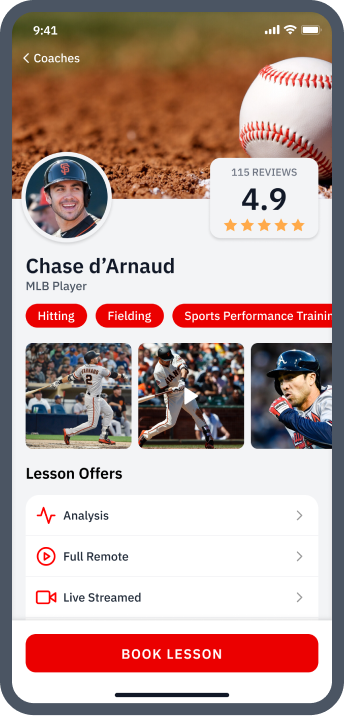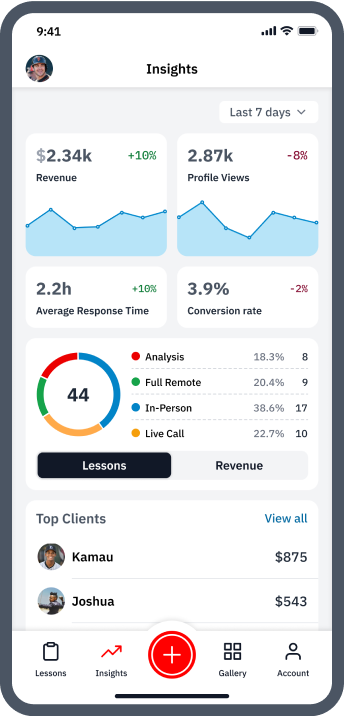Remote Coaching: The New Landscape of Online Baseball and Softball Instruction
Remote work has been gaining in popularity for well over a decade. But the pandemic turned what was a growing trend into a temporary way of life for almost the entire world.
Many experts now predict that much of the sudden at-home labor force that resulted from the coronavirus pandemic could be here to stay because remote work is a game-changer for both traditionally employed and self-employed individuals alike.
In fact, the investment firm Betterment found that about 33 percent of all remote workers in the U.S. were self-employed, and they expect that number to keep climbing.
Predictions around the future of remote work are bolstered by the explosion of what’s being called the “creator economy.”
This refers to the millions of people with talent, skills, and passion in one area who decided to quit their day jobs and focus on creating content, informational products, or offering private instruction in that area full-time.
Though it essentially describes the same phenomenon as “creator,” we’re partial to the term “Coachprenuer” when talking about the people we built SeamsUp for.
That's because it balances an entrepreneurial, self-starter spirit with the coach mindset of positively affecting the development and lives of as many up-and-coming athletes as possible.
And baseball and softball have been no exception to these remote trends, with video training courses and 1:1 online instruction becoming widely available like never before.
With remote work having its moment and online training skyrocketing in popularity, there’s never been a better time to offer online baseball or softball coaching.
This in-depth guide will cover five main ideas:
- How the pandemic affected remote coaching, working, and learning
- Notable trends and statistics in remote working
- Benefits of remote working
- Struggles of remote working
- How to become a remote baseball or softball lesson instructor
The Pandemic Forced Many Ballplayers and Coaches to Go Remote for Instruction

As alluded to earlier, the remote working uptick that resulted from the coronavirus pandemic has actually been a long while in the making.
Global Workplace Analytics says that the remote workforce had increased by 140 percent between 2005 and 2019.
And as remote work became more the norm, rather than the exception, employees began seeking out jobs that offered flexible working options.
Then the pandemic hit, and a much larger portion of the global workforce was forced to go remote.
Some businesses were ready for the shift, having already started working with remote or hybrid teams long before.
Similarly, self-employed creators who’ve always worked remotely, like baseball or softball social media influencers, were less affected financially by this shift.
But this pandemic profoundly affected many coaches who primarily make their living as in-person private lesson instructors or paid field coaches.
However, a new, remote lifestyle affected more than personal finances back in 2020.
As people in many countries around the world were forced to stay home ostensibly to help reduce the number of COVID-19 cases, online media consumption ballooned.
Streaming services like YouTube and Netflix saw significant viewership jumps from the end of March and into April. People watched more movies, TV series, and videos for entertainment, but they also watched informational videos.
Being homebound prompted many people to want to learn a new skill or improve on old ones. It’s not surprising, then, that sports and fitness videos proliferated during the pandemic.
People stuck at home clamored for workout videos, and fitness gurus obliged. With limited options for exercising while homebound, people found their favorite trainers on YouTube, Instagram, or Facebook.
Some instructors even held classes live or webinar-style, so people could follow along and engage in the comments section in real-time.
Many baseball and softball instructors learned from the success of exercise and fitness gurus during the pandemic.

What did this mean for baseball and softball athletes?
Quarantine in March, April, and May was particularly hard on baseball and softball players and fans, as springtime is usually when new seasons get underway.
Most college and high school seasons were called off that year, the MLB postponed, and the NPF canceled their 2020 season altogether.
Many athletes were stuck at home, finding creative ways to keep training until their seasons could start later in the year.
This tragedy for so many young athletes and fans had the unintended consequence of exposing millions to some version of remote baseball or softball instruction.
Coaches that previously held in-person pitching or hitting lessons moved their sessions with athletes to Zoom, Google Hangouts, or other webinar platforms.
And hundreds of coaches took DM’ed practice or game footage to analyze and return back to paying clients.
Lastly, Coachpreneurs that offered instructional video courses suddenly had a much larger, more interested audience pool.

There’s never been a better time to be a remote baseball or softball instructor
Even as lockdown restrictions finally loosened and in-person training was thankfully allowed again, the want and need for remote instruction didn’t disappear.
If you offer remote training, you can help athletes all over the country and, depending on the platform you choose to coach with, throughout the entire world.
And baseball and softball players can benefit immensely from access to great instructors without any geographical limitations.
Why should they only have the option to learn from a handful of local instructors when they can work directly and meaningfully with the best players and coaches in the world?
But in order to see why becoming a Coachpreneur is such a great option, let’s first dive deeper into the world of remote work.

Remote Work – Statistics and Insights for Baseball and Softball Instructors
Earlier, we mentioned that remote working was popular, but just how common is it?
According to studies by IWG, about 70 percent of the entire global workforce already works outside of a traditional office, AKA telecommutes, at least one day a week.
Remote working then is widespread, but how do you know if it’s right for you and your Coachprenuer business?
Let’s look at some stats and notable trends in the world of remote work so you’ll have all the facts.
Wanna grow your baseball or softball coaching brand?
Get connected to new local and online lesson clients—along with all the tools you need to scale.
Download the free app

Remote Coaches Are Happier
According to the State of Remote Work 2020 survey conducted by Buffer and AngelList, one thing about remote workers is clear: once they start working remotely, they prefer to keep doing so.
When researchers asked current remote workers if they wanted to work remotely, at least partially, for the rest of their careers, a whopping 98 percent said yes.
And 97 percent said they’d recommend remote working to others. A clear majority of the people surveyed worked remotely full-time, as well.
Teleworkers, just another name for remote workers, appear to be content with their situation. Indeed, the survey concluded that such workers are happiest when they spend more than 76 percent of their time working remotely.
Remote work has also become more of a priority for workers in recent years, as 74 percent of employees would be willing to quit their job and take one that offers flexible remote options.
One reason that remote workers might be happier is a better work-life balance.
According to a study done by Owl Labs, many teleworkers report feeling less stressed when working from home.
With a more flexible work schedule, remote workers can better plan to spend time with their families. Not to mention, better work-life balance leads to less stress and improved overall health.
Conducting remote baseball or softball lessons or building a personal brand and offering informational products can mean true freedom for many coaches.

Remote Coaches Are More Productive
Many studies have been done linking working from home to productivity.
In particular, a study by Stanford found remote workers to be about 13 percent more productive than their in-office counterparts.
Part of this increased productivity is likely linked to workers doing work when they feel most inspired instead of based on some archaic 9 to 5 model. But remote workers also tend to take fewer sick days off from work.
Teleworkers also feel more productive – which differs from whether they actually get more work done or not – and cited fewer distractions or less stress as their main reasons.
And coaches and athletes know that when you feel more of something, like confidence, you tend to embody and become that feeling.

Does Remote Coaching Mean Working from Home?
When you picture remote workers, do you imagine someone sitting in their home office or at a trendy coffee shop?
Teleworkers frequent both locations, although working from home is more statistically common.
Buffer saw that 80 percent of their remote worker respondents worked primarily at home. But many would go to coworking spaces, coffee shops, or even their company’s office as secondary locations.
Jobs that can be done from home, with a tablet or phone, and an internet connection, are, of course, better suited to teleworking.
As a baseball or softball instructor, you have total freedom to work wherever you like.
This applies to both the type of lesson where you analyze players’ sent footage and provide them with drills and personal feedback and the type where you live stream calls directly with clients.
As a baseball or softball instructor, though, you might choose to venture out to those local diamonds or training facilities when filming content specifically for your online video courses.
Location independence has also been cited as a top benefit of remote working. With more chances of having a job at a distance, employees and freelance creators can choose to live wherever they want.
If you build a personal brand online, you don’t have to live in a large urban center where many top travel ball organizations are located. You can live in a small town or even overseas if it suits you.
Many potential lesson clients are increasingly concerned with having the best teacher possible, no matter where they’re located. That gives remote coaches an advantage.

Benefits of Online Baseball and Softball Instruction
The positive aspects of remote work touch all areas and axises of modern life – the physical, psychological, emotional, and financial.
For example, when compared to traditional in-person roles, remote working is a money-saver.
Let’s discuss in more detail the main reasons people love working remotely before tackling the top struggles they face.
Top Benefits of Remote Coaching
The top three benefits that people cite for remote working in general are greater flexibility, no commute, and spending much more time with family.
These are pretty powerful benefits.

Flexibility
Unsurprisingly, most people cite flexibility as their top concern when it comes to remote working.
Companies with remote teams often let their employees choose their own schedule, so long as they complete their work.
Remote freelancers and creators don’t even have an organization to report to for their schedule – self-employment allows you to work whichever hours you like best.
58% of remote workers said that either a flexible schedule or the flexibility to work from anywhere were the biggest benefits of working remotely.
As a baseball or softball instructor, you have the freedom to work when you want and where you want, so long as you’re able to connect with your athletes.

No Commute
Working from home means no morning and evening commute, and it’s one of the biggest benefits remote workers claim.
Commutes are a huge waste on all fronts.
Commutes require you to spend more money on fuel for your car or subscriptions to public transportation networks.
Over time, driving commuters will also need more maintenance done on their vehicle. Compounded each year, these costs add up.
Commuting not only costs more money but also contributes significantly to stress.
The Ford European Commuter Survey found that amongst commuters in large cities like Barcelona, Berlin, London, Madrid, Paris, and Rome, the travel to and from work was more stressful than their actual job.
Many workers will even consider their commute the worst part of their day.
The stress of these feelings and long commutes can actually have many negative effects on the individual's physical and mental health.
Lastly, as more and more workers shift to teleworking, the reduction in commutes will have national and global second-order benefits.
Less commuting can mean fewer carbon emissions, reduced total energy use, less stress on public transportation infrastructure, healthier home lives that lead to positive repercussions both now and for future generations, and a shrinking urban-rural economic divide.

Spending Time with Family
A stronger work-life balance is a big motivator for people who want to work remotely.
Remote work leads to healthier home life for a few reasons:
- No commute means more spare time to spend with family members
- Working at home allows you to be closer to family members during the day
- Greater productivity and less stress makes you an overall happier person to be around
- The household can save significant amounts of money on child or elderly care
As the effects of stronger work-life balance take hold amongst remote workers, their office colleagues are starting to demand more flexible work-from-home time too.
Many people have family obligations, like caring for children or elderly parents, so being able to spend adequate time with them is a big advantage to all remote working.
As stated, monetary savings on childcare is another big feather in the cap of remote working arrangements.
Remote workers have the flexibility to arrange their schedules around their children, so they don’t have to pay for expensive daycare, babysitters, or after-school programs.
Aside from saving tons of money, there’s also the added benefit of being much more present in the lives and development of your children. And the same can be said for those who want to be active in the lives of their aging parents.
There are a few extra gadgets that might make conducting quality-looking and sounding informational courses and remote lessons easier.
But, all you really need as a baseball or softball coach wanting to go remote is a cell phone with internet.
It's a pretty low barrier of entry considering all the benefits.

Struggles of Remote Coaching
To have an accurate view of remote working, we need to consider the negatives as well.
The three main challenges that some remote baseball or softball teachers might face are home distractions, different time zones, and taking vacation time.
Distractions at home
Working from home, surrounded by all your stuff and your family, can lead to possible distractions for some coaches.
But it helps to create a designated space in your home from which to do your remote lessons or film your informational course content.
This can be a home office, a space in your backyard, or in the garage.
Of course, you can always just do your lessons or course shooting at a local park whenever you like instead.
Another common practice for instructors who do both in-person and online lessons is doing online remote lessons inside the same training facility that they use for their in-person lessons.
You simply work with your online clients before, in-between, or after your in-person clients.

Different Time Zones
Remote jobs are great because they can put people from all over the world on the same team. But differing time zones have long been a challenge for remote workers of all kinds.
Luckily, for baseball and softball coaches like yourself, this problem has been solved.
For lessons where clients send over footage to be analyzed and returned with your professional feedback, you, as the coach, choose when it's most convenient for you to provide that analysis and feedback – you have total freedom in this regard.
But, you might be thinking, what about when I want to offer live call remote lessons, like a Zoom-type call, with players across the country or in Japan – where baseball and softball are also very popular?
Yes, then such time zones certainly used to be a challenge.
But, apps like SeamsUp have created fully automated scheduling software that does all the time zone matching work for both you and your clients.

You simply enter the days and times each week that you would like to offer live call lessons – it takes just a few seconds and can be edited anytime you want.
Then when clients across the country or living abroad go to request a live call lesson with you, the days and times that you entered as your weekly availability will show to the client as translated into their own location’s time zone.
So, any day and time that the client chooses will be one of your available slots, but you still have the ability to accept or deny the request and even cancel the scheduled lesson anytime if your availability were to change.
For example, suppose you’re a baseball coach giving lessons in California, and you are available to give lessons at 4 pm on Fridays, and a ballplayer in Japan wants to work with you.
The ballplayer will see this same time slot on their side as 8 am on Saturday, and they will be thrilled to work with you in a live stream lesson right before their weekend’s big game.

Taking Vacation Time
Taking time off wasn’t the biggest challenge for remote workers cited in polls, but it’s up there. Vacations don't come so easily to remote workers for a few reasons.
Freelance entrepreneurs might have a workaholic mentality that pressures them to work more and rest less.
Also, since they already have a flexible schedule, some may not feel that they should take full days off.
In the case of Coachprenuers, vacation days can be hard to come by because you’re your own boss, and you are directly invested in all of the work you do.
Online lesson apps often give you the ability to adjust your availability for a vacation or deny requests in just one tap, so the choice to rest really just comes down to self care and recovery.
And the power of recovery should be well-known to all elite athletes and coaches in the modern era.
As you can see, there are a few challenges to remote working. As more and more people switch to working from home, however, solutions to these struggles, like those mentioned above, will continue developing.
Experts predict that the future of work is remote and expect that any tools and resources that can further facilitate remote working will catch up to the needs of teleworkers soon.

How Online Lessons Help Your Baseball and Softball Players
So far, we’ve talked about giving online private lessons from the perspective of you, the coach. But there are also some compelling benefits for your potential clients.
Remote instruction has a lot of science behind it.
The history of video analysis alone goes back to the 1950s. And researchers have been studying the startling results that happen when its principles are applied to sports performance for decades.
Moreover, by their very nature, virtual hitting, pitching, catching, fielding, or sport performance lessons unlock accelerated skill growth and more long-term retention of new mechanics and concepts for your ballplayers.
The psychological mechanisms underpinning such inherent online lesson growth are at the cutting-edge of educational theory and performance science.
We’ve explored a few of these in serious depth. Check out our writings on the spacing effect, delayed learning, microlearning, and Zeigarnik effect.
We’ve even dived headfirst into the feel vs. real controversy that’s everywhere in our games and shown how video analysis – whether it’s in-person with your student, over a live streaming video call, or happening not in real-time at all – is key to understanding and rectifying the entire phenomenon.

How to Be a Remote Baseball or Softball Lesson Coach
For coach entrepreneurs looking to earn revenue online there are a lot of options.
But your lifetime of expertise in the game uniquely suits you best for two things: giving online private lessons and creating instructional courses.
Our free in-person and online instructional platform is an obvious place to start if you're interested in giving private hitting, pitching, catching, fielding, sports performance, or recruiting advice lessons.
And don’t miss our profit calculators to see just how life-changing this choice can really be.
But offering online video courses is, again, another great way to provide value as a player or team coach. So, also don’t miss our in-depth and actionable free guide on how to create a baseball or softball video course.

Wrapping Up on Remote Baseball and Softball Training
Remote working is no longer a thing of the future. As digital communication tools grow more sophisticated, teleworking arrangements will only increase.
The opportunities for remote workers were accelerated exponentially as a result of the 2020 pandemic, when a huge portion of the global workforce saw how easily their jobs could be done from anywhere.
If you’ve always wanted to teach baseball or softball for a living but didn’t know how to get started, now is the time to launch your Coachprenuer business.
And there are plenty of tools and resources at your disposal to help you out at every step of the journey, so what are you waiting for?
Wanna grow your baseball or softball coaching brand?
Get connected to new local and online lesson clients—along with all the tools you need to scale.
Download the free app

About the Authors
Courtney Withrow
Professional Writer
Originally from the U.S., Courtney is a Brussels-based freelance writer with a Master’s degree in International Relations. She grew up playing softball and still loves the game.
Mike Rogers
Co-Founder & CEO
Mike Rogers has spent a lifetime entrenched in baseball and softball as a player, a private instructor, a training facility owner, and the son of two college-level coaches.

